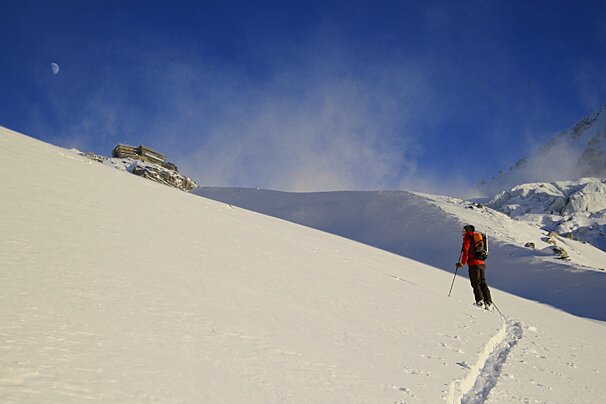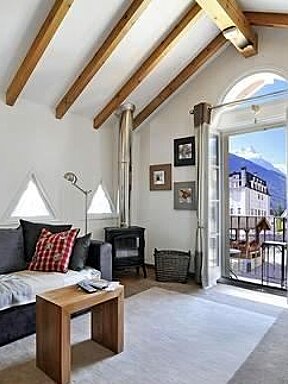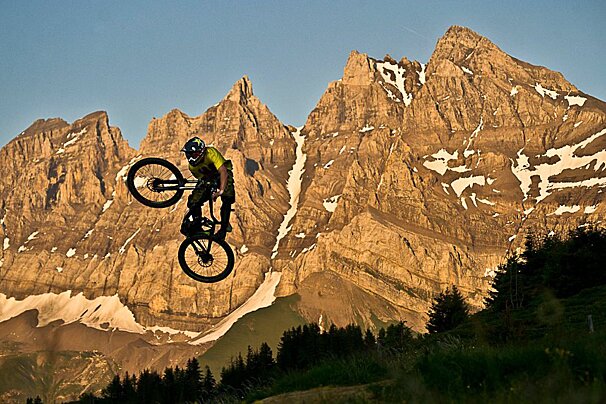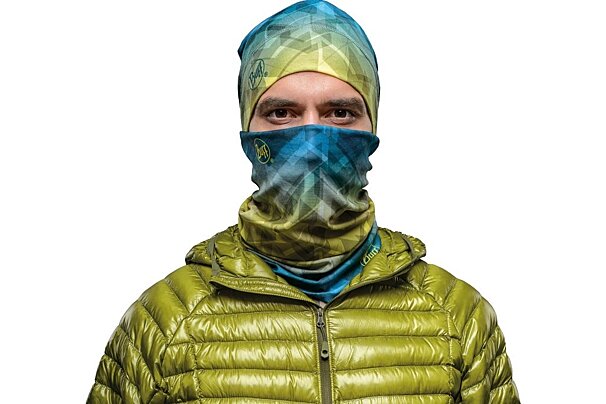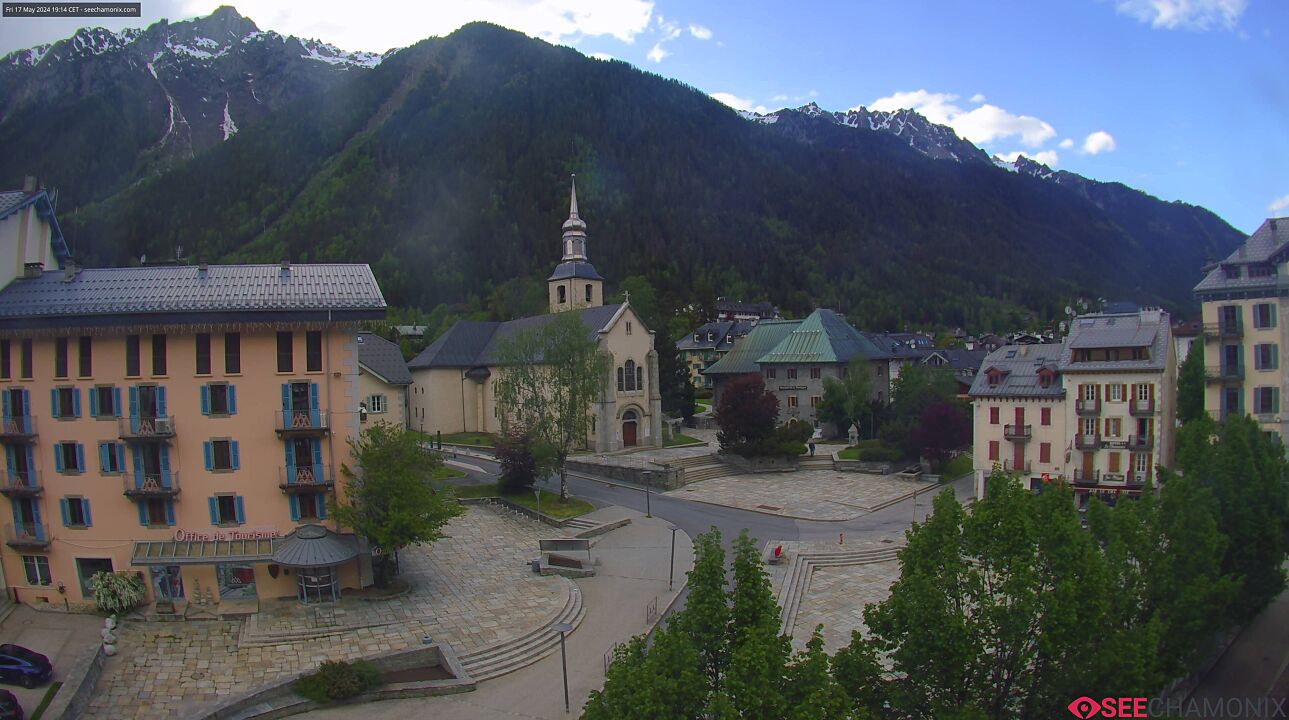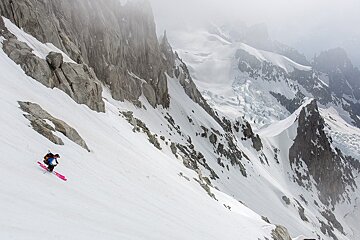
© T Oliver
Ski touring in Chamonix
Discover the top Chamonix backcountry skiing
Limitless blue skies, pierced by bright sunlight and the sharp Aiguille ranges of the Chamonix valley makes ski touring here something spectacular and magical. There's hundreds of miles of mountain for the backcountry explorer to enjoy around Chamonix, all of which is fairly accessible after a short hike from some of Chamonix's excellent lift system.
Many of those who choose to take on Chamonix's ski tours are experienced mountain riders, after all this is a serious sport. Always respect the mountain, understand the conditions you are riding in, know your route, and always make sure you are appropriately equipped. Essentials to carry are all included within our Avalanche Awareness article, but in summary, they should include a transceiver, shovel, probe, backpack, ropes, harness, crampons/snowshoes, poles and plenty of fluids (you'll dehydrate must faster at altitude). Many people will access the backcountry with snowshoes, but using skins on the bottom of your skis is far easier and faster. Snowboarders may prefer to use 'mini skis' as an alternative. Whatever your mode of approach, you should be relatively fit and strong and be ready to hike.
Please note: if you ignore safety warnings and barriers/ropes and undertake off-piste skiing/boarding you do so at your own risk. We always recommend that you take a mountain guide when heading off-piste. Skiing or snowboarding off-piste may result in injury or death even with a professional mountain guide or instructor. The following is not a set of directions or instructions, we accept no responsibility for the use of this information.
Watch this
Ski Touring Routes in Brévent and Flégère
Some of the most popular ski touring routes in the Chamonix valley begin from the top of the Index chairlift at Flégère. They involve a fair bit of mountaineering knowledge as well as off-piste skiing and avalanche safety techniques. La Flégère and Le Tour/Balme, a little further up the valley, are known locally as having some of the best natural terrain for freestyle, with gullies that form natural half pipes, rollers, cornices and jumps everywhere you look.
These are just a few suggested routes for backcountry touring from Flégère. They're far from comprehensive but offer a taster of what’s possible if you want to stray from the regular pistes. Most of our routes finish in Le Buet, which is at the foot of the Bérard valley. From Le Buet, you can catch a train back to Chamonix or take the Vallorcine lift if you fancy skiing further and exploring the Le Tour/Balme lift system.
There are several excellent guidebooks with descriptions of the many possible routes both within and beyond the lift areas. There are two published by Vamos called Mont-Blanc Ski tours (ISBN 2910672085) and Chamonix Hors Pistes-Off piste (ISBN 2910672107); these books are bilingual, in English and French. An even more extensive guidebook with more difficult routes is Mont-Blanc et Aiguilles Rouges à ski (ISBN 2960025520), written by Anselme Baud and published by Nevicata; it’s only available in French but is worth struggling through even if your French isn’t so good as it gives very accurate descriptions and has good explanatory photos. But remember, in the backcountry there are many dangers not least from cliffs and avalanches so you should always hire a Chamonix guide.
If hiking isn’t your thing but you love powder then heli-skiing/boarding could be for you. Whilst helicopter drops of this nature are illegal in France (as you land on National park), Chamonix is well located with plenty of companies offering heli-drops on the Mont-Blanc massif just over the border in either Switzerland or Italy.
The Col des Crochues at Flégère gives access to the Col de Bérard (easiest), Bérard Breche and Glacier Mort (hardest) routes. Take the cable car up from Les Praz, the Index chair and then the Floria drag lift. From there the Col des Crochues looks right up the hill. The skin to the top takes on average 40 minutes for those with a good level of fitness. The top section becomes quite steep so you'll need to boot pack up this (it’s not normally necessary to use crampons in this section). On warm spring days, this climb can be prone to wet snow slides so this route is best done early in the morning.
Route 1: Col de Bérard
For the Col de Bérard it’s a long traverse skiers right from the Col des Crochues. You should try to stay as high as possible on the traverse until you reach the flat section and can go no further. Something to watch out for on the traverse is the avalanche risk from the slopes above. These slopes catch the sun and warm up causing inevitable slides onto the traverse below, and if caught in one of these slides you could possibly be carried over the cliffs that sit below some sections of the traverse. If you take this traverse too early in the morning it can also be icy and difficult, so the trick is to catch it just as it’s softening up. From the flat section you can put on your skins and head right to the Col; a relatively short hike of 15-20 minutes to the Col de Bérard. You can often expect good snow in the Bérard Valley as its slopes are not too steep and the route down is fairly straight forward. Continue following the valley down until you reach the trees and river which lead out of the valley towards Le Buet. If you do this route on a snowboard you may find the last section by the river is a bit of a drag as there are short uphill sections where you may have to walk. The path by the river leads all the way down to Le Buet where the Le Buet Hotel offers a rest stop for a well-deserved beer.
Route 2: Bérard Breche
The Bérard Breche hike is quite a bit longer than the Col de Bérard so should only really be attempted if you’re feeling pretty fit. Instead of going to the skiers’ right of the Col des Crochues, you need to climb the ridge to the North. Continue down into the small valley below the flat area before commencing the hike up the facing wide gully, and following on above to the open slopes that lead to the Petite Aiguille de Bérard. From there follow the ridge that leads up to the right in the direction of Breche. Near the top, traverse below the ridge to reach the rocky notch, which is the Breche. As you climb up through the notch you’ll see the Bérard Valley below. It’s a demanding hike of about 90 minutes but delivers you almost to the very top of the Bérard Valley and offers a longer descent than the Col de Bérard described above. On the route down beware of the cliff directly below the Breche, you can traverse skiers’ left to avoid it. The rest of the route is open with rolling terrain down to the bottom of the valley where the route out is the same as for the Col de Bérard.
Route 3: Glacier Mort
For Glacier Mort (translated as 'dead glacier'), take the traverse from the Col des Crochues but stop halfway along the traverse and climb the large couloir on the right towards the Point Alphonse Favre. For the lower part of the climb you may need skins or snowshoes, but from halfway up where it gets steeper boot packing is better. At the top of the couloir follow the rocky ridge up to the right. The rocks provide good hand holds on the last steep pitch, however if it is icy, crampons are highly recommended. This climb can be intimidating due to the steepness of the latter sections, and also because it was the toughest of the three, but if you’re looking for some great powder, the last little steep slog is definitely worth it. From the top, (which can be cold and windy even on warm days), traverse to the right to avoid the rock band below and then traverse back left below the rocks to the top of the open gully below. The terrain here is superb with most of it shady and protected from the sun. Follow the gully down, making the most of its powder until it opens out from where you follow the valley down to meet the river and trees for the exit to Le Buet.
Other popular routes in the area include hiking out to Lac Blanc where you can head into the Bérard Valley via the Col de Belvedere (although be sure to bring the appropriate kit with you as there is some abseiling required) and the Col de Beugeant.
It’s always recommended that you take a mountain guide when you do these routes. Mountain guides have the best knowledge of the snow conditions and dangers involved including the avalanche risks at the time. A guide will make sure that you ride the best snow possible and pick a route that is most suitable for your group.
Ski Touring Routes in the Domaine de Balme
In one moment you can be skiing in France, the next in Switzerland, there are very few other ski resorts that can offer the same in their ski tours. Many of the routes incorporate glacial terrain so a good knowledge of crevasse rescue is essential as well as avalanche safety equipment and techniques. Even if you have invested in one of the books we have previously recommended, remember, in the backcountry there are many dangers not least from cliffs and avalanches so you should always hire a Chamonix guide.
The Grands Autannes
A favourite ski-tour, it’s best to set off as early as possible because the slopes of the Grands Autannes are steep and catch the sun in the afternoon. Take the gondola up from Le Tour, then the Autannes chairlift. Next comes the hard part; either on snowshoes or skins start the ascent up the slopes in front of you. Sometimes it’s best to go up onto the ridge and follow it along to the couloirs, at other times if it looks safe it’s easiest just to head straight up the couloirs. It’s a deceptive climb as it doesn’t look very steep from below, but the upper section by the GAZEX tubes can be intimidating and you need crampons for the last section. At the first saddle, head to the right up the last short rock scramble to the small peak. Once at the top you’ll realise it’s worth the climb, as you have a great view over the back to the Trient glacier.
For the descent to Trient, stay high and traverse skier’s right, avoiding the rock bands below until you reach the open bowl. From there it’s open powder all the way. If you look left you can see the Col de Balme and the restaurant there. Below that is the long gully that leads to Trient. There are several small and steep chutes that lead into the main gully or you can pick your way through the bushes. The chutes are better, but beware of wind-loading, as you can set off small slab slides. Don’t hang around in the main gully, because it's a serious avalanche channel. After a big snowfall this place is extremely high risk. Follow the big gully down, and head left at the bottom into the meadows. Follow the ski de fond trail to Trient and have a beer at the café while you wait for the bus. Job done, powder run completed.
PS. Don’t forget to take your passport on this trip as you may be asked for it when you head back over the border into France.
Ski Touring Routes in Grands Montets
Some of the world's best backcountry terrain found in Chamonix is high up on the glaciers accessed from the Aiguille du Midi and Grands Montets cable cars (Argentière). They offer access to numerous kilometres of high mountain powder with even more if you like to hike for fresh lines. From the very top of the Grands Montets cable car (not reopening until 2024) you have access to powder and glacial terrain. Up here are some of the world's best and most famous ski tours.
With some glacier travel knowledge, there are a vast amount of ski tours available from the top of Les Grand Montets. There are countless possibilities of varying degrees of difficulty. Some of the best-known ski tours include Col du Chardonnet, Col d'Argentière, Col du Tour Noir and also some steeper variants such as Col du Cristaux.
If hiking isn’t your thing but you love powder then heli-skiing/boarding could be for you. Whilst helicopter drop-offs of this nature are illegal in France (as you land on National park), Chamonix is well located with plenty of companies offering heli-drops on the Mont-Blanc massif just over the border in either Switzerland or Italy.
For backcountry skiing and snowboarding from Grands Montets it is strongly recommended that you use the services of a local mountain guide unless somebody in your party is local to the area and knows the country really well. You need somebody who knows their mountaineering because it’s all on glacier and the route finding can be complex. Some of the more popular routes are the Pas de Chèvre and Col du Passon. The Pas de Chèvre has a few variations in route and difficulty.

Ski Touring Routes in Les Houches
The Les Houches ski touring route allows beginners to get a taste for the sport without having to head off into the unknown.
The trail starts at Les Chavants, near to the bus stop at the Prarion lift station. The route is marked along the way and climbs from 1,012m at the base to 1,860m at the top of the Prarion gondola – giving you a good old 848m uphill leg workout. The marked trail can be seen here and you can also find it on the piste map for Les Houches.
The Les Houches trail is a great introduction to the sport, as the route is clearly marked and has been chosen for its safety and accessibility. You don't need to be an experienced off-piste skier as the end of the trail brings you out into the centre of the pisted ski area. Touring kit of skis, boots, bindings and skins can be hired fairly inexpensively from most sports shops.
More inspiration...
Take a look at this year's Ski Pass Prices or, if you're not sure which pass to buy, read Ski Pass Options for more information.




